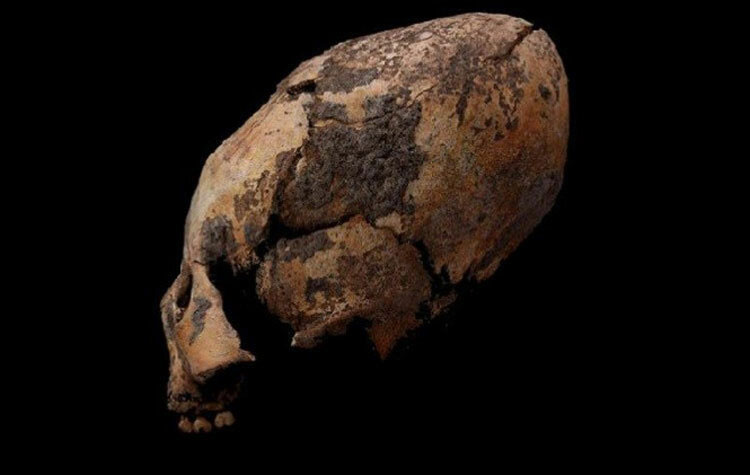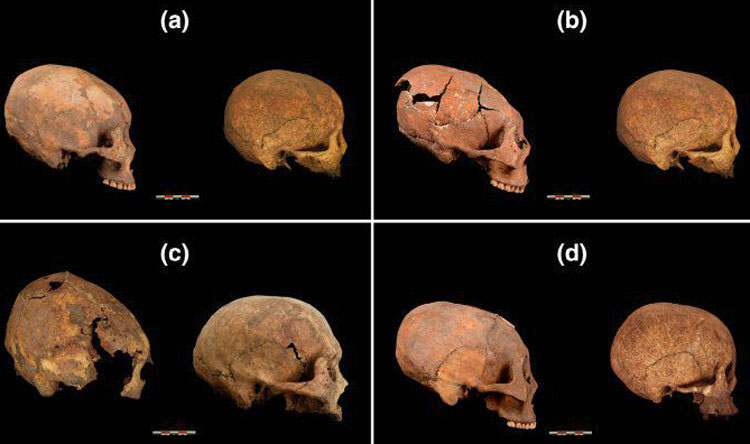Chinese people long-necked skull to express power?
The infant's skull is shaped by using two hands or clamping two splints, fixed with a cloth wrapped around for a long time.
The research team of the International Biological Research Center of Jilin University, China has just published in the American Physical Anthropology magazine about the discovery of 11 human skeletons with strange skull shapes excavated in the area. Houtaomuga archeology , China. The study found that there were 5 adult skulls and 6 skulls at the stage of young children aged 3 - 40 years old, skulls dating from 5,000-12,000 years.

Prolonged skulls were excavated in Houtaomuga, China.(Photo: Zhang and the team).
To prolong the skull, the ancient Chinese may have used their hands to squeeze the infant's skull or use two fixed plates of cloth wrapped around them. Surprisingly, this approach does not negatively impact the cognitive ability of the subject, explains Bruce Bower in Science News.
In the Chinese Houtaomuga region, the people's skull is buried with precious possessions showing high status in society. However, this practice may only take place in certain noble families. Mr. Xijun Ni, biologist archaeologist at the Chinese Academy of Sciences, gave evidence, in the skull group found, an oldest chronological skull about 12,000 years old is of an adult man interference to prolong.

Modified skull (left look in each box) compared to the unchanged skull.(Photo: Zhang and colleagues).
According to author Michelle Starr of Science Alert, skull-long practice is practiced across cultures around the world for thousands of years for different reasons. Some cultures maintain this practice to show status, wealth and power in society, while others extend children's skulls with the aim to protect brain development. This practice takes place over a long period of time and cannot be changed even while buried.
Earlier, the discovery of the elongated skull of Neanderthals, dating back to 45,000 years old in Iraq, is believed to be the oldest. However, this finding has not been recognized by scientists. So far, the new 13,000-year-old Australian skull is a testament to the longest-running custom of the skull.
Researchers believe that it is too early to conclude that the ancient practice of skulls of ancient Chinese is the earliest custom in East Asia and the cause of prolonged skulls should also be sought. understand more.
- The custom of extending the skull of the South American tribe
- The skull is as long as the aliens of ancient Eastern European women
- Discovered reptilian skull 70 million years
- Found 16,000-year-old human skull nearly intact
- Discover long-necked dinosaurs in the ice continent
- Brazil discovered the world's oldest long-necked fossil dinosaurs
- A long-necked predator in the sea
- The long-necked sea monster in the UK may be a new dinosaur
- Discover the village with strange long-necked women
- Long-necked dinosaurs do not face the neck up high?
- Why are long-necked dinosaurs gigantic?
- The skull is as long as the aliens of ancient Eastern European women
- Finding dinosaurs with super long necks
- Dinosaurs also migrate
 Discovered an ancient centipede fossil 99 million years old
Discovered an ancient centipede fossil 99 million years old Discovered bat-like dinosaurs in China
Discovered bat-like dinosaurs in China Discovered a 200-year-old bronze cannon of the coast
Discovered a 200-year-old bronze cannon of the coast Discover 305 million-year-old spider fossils
Discover 305 million-year-old spider fossils